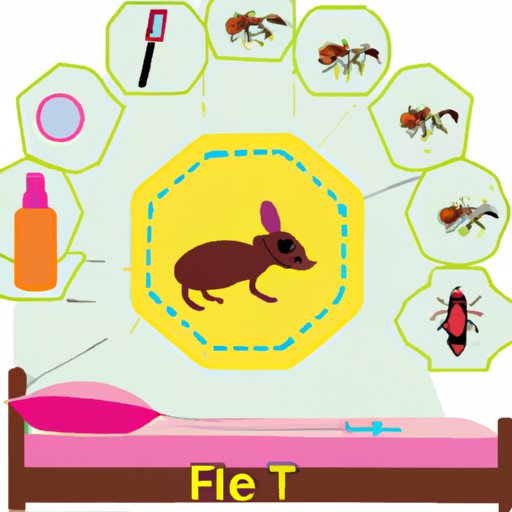Introduction
Fleas are tiny parasites that feed off the blood of mammals and birds. Although they can be found almost anywhere, one of the most common places for fleas to inhabit is beds. If you’re worried you might have fleas in your bed, it’s important to know how to identify them and take action to get rid of them.
It’s essential to identify fleas in your bed because they can cause a range of problems, including skin irritation, allergies, and even disease. Therefore, it’s important to be aware of the signs of fleas and take steps to eliminate them quickly.
Signs of Fleas in Your Bed
The first step in identifying fleas in your bed is to look for visible signs. Here are some of the most common signs to watch out for:
Check for Small, Dark Specks on Bedding and Furniture
One of the most obvious signs of fleas in your bed are small, dark specks on your bedding and furniture. These specks are actually flea droppings, which are made up of digested blood.
Look for Tiny, Reddish-Brown Bugs Moving Around the Bed
If you look closely, you may also spot tiny reddish-brown bugs moving around the bed. These are adult fleas, and they can jump up to 6 inches in the air. Be sure to check any crevices or cracks in the bed frame as these are prime spots for fleas to hide.
Inspect for Flea Droppings – Small Black or Brown Dots
Another sign of fleas in your bed is flea droppings, which are small black or brown dots. These droppings are often mistaken for dirt, but if you rub them between your fingers, they will turn a reddish-brown color.
Check Your Pet for Signs of Fleas
If you have a pet, it’s also important to check them for signs of fleas. Fleas will often congregate around the ears, neck, and tail of animals, so be sure to inspect those areas closely. You may also notice your pet scratching or biting themselves more than usual, which could be a sign of flea bites.
Look for Signs of Flea Eggs – Small White Specks
Flea eggs are small white specks that can be found in the fur or feathers of animals. They are very hard to see, but if you look closely you may be able to spot them. Flea eggs are usually about 1/16 of an inch long and oval-shaped.
Feel for Flea Bites on Your Skin
Finally, if you wake up with red, itchy bites on your body, this could be a sign of fleas. Flea bites are usually found on the arms, legs, and feet, and they can be quite painful. If you think you have been bitten by fleas, it’s important to seek medical advice as soon as possible.
Solutions
Once you have identified fleas in your bed, it’s important to take action to get rid of them. Here are some of the most effective solutions for dealing with a flea infestation:
Choose an Appropriate Flea Treatment
The first step in getting rid of fleas is to choose an appropriate flea treatment. There are a variety of flea treatments available, including sprays, powders, and shampoos. It’s important to read the instructions carefully and follow them precisely to ensure that the treatment is effective.
Vacuum Regularly
Vacuuming regularly is also an effective way to get rid of fleas. Vacuuming will help to remove flea eggs, larvae, and adult fleas from carpets, furniture, and bedding. Be sure to empty the vacuum bag or container after each use to prevent the fleas from spreading.
Wash Bedding and Clothing in Hot Water
It’s also important to wash all bedding and clothing in hot water. This will help to kill any fleas or eggs that may be hiding in the material. Be sure to use a hot cycle on your washing machine and dry the items on the highest heat setting.
Conclusion
Identifying fleas in your bed is an important step in preventing an infestation. Be sure to look for small, dark specks on bedding and furniture, tiny reddish-brown bugs moving around the bed, flea droppings, flea eggs, and flea bites on your skin. Once you have identified fleas in your bed, take steps to eliminate them using flea treatments, vacuuming, and washing bedding and clothing in hot water.
By taking action quickly, you can reduce the risk of a flea infestation in your home and keep yourself, your family, and your pets safe from harm.


